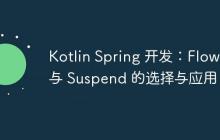-

- Kotlin Spring 开发:Flow 与 Suspend 的选择与应用
- 本文旨在帮助JavaSpring开发者快速理解Kotlin中的Flow和Suspend函数,并指导如何在Spring项目中正确使用它们。文章将阐述Flow和Suspend的区别,提供选择建议,并避免常见的误用情况,帮助开发者构建高效且易于维护的KotlinSpring应用。
- 后端开发 . spring-boot 628 2025-08-02 21:24:22
-

- 解决Spring Boot JDBC连接Azure PostgreSQL失败问题
- 本文旨在帮助开发者解决SpringBoot应用通过JDBC连接AzurePostgreSQL数据库时遇到的连接失败问题。通过分析常见的配置错误和网络问题,提供一系列排查和解决问题的步骤,包括检查数据库连接字符串、防火墙设置、SSL配置以及必要的服务器重启操作。最终,帮助开发者成功建立与AzurePostgreSQL数据库的稳定连接。
- 后端开发 . spring-boot 768 2025-08-02 18:02:16
-

- VSCode如何配置Kotlin开发环境 VSCodeAndroid开发的优化设置
- VSCode可通过安装JDK、Kotlin扩展、GradleTasks等插件配置Kotlin开发环境,实现语法高亮、代码补全和构建任务执行;2.用于Android开发时可胜任代码编辑、Git管理、终端命令执行等轻量级任务,但缺乏布局可视化、深度调试和性能分析等完整IDE功能;3.常见问题包括JDK版本不兼容、环境变量未正确配置、扩展冲突及项目同步困难,需逐一排查解决;4.在移动开发中更适合作为辅助工具,其优势体现在Flutter、ReactNative等跨平台框架及后端服务开发,而非原生Andr
- 后端开发 . spring-boot 394 2025-08-02 13:02:01
-

- MySQL如何结合Kotlin进行移动端开发 MySQL在Android应用中的高效数据存取方案
- 不推荐直接将MySQL数据库连接到移动端应用,因为存在严重的安全隐患、性能瓶颈和维护难题;2.高效的解决方案是通过Kotlin编写的Android应用与后端RESTfulAPI通信,由API服务间接处理MySQL操作;3.使用Retrofit进行类型安全的HTTP请求,结合Kotlin协程实现异步网络调用,提升代码可读性和UI流畅性;4.利用Room数据库在本地缓存数据,实现离线访问和快速响应,优化用户体验;5.后端需做好API版本控制、HTTPS加密、认证授权、输入验证和敏感数据保护,确保系统
- 后端开发 . spring-boot 893 2025-08-02 09:05:01
-

- java如何使用注解实现自定义拦截器 java注解拦截器实现的基础入门教程
- 定义注解:创建一个运行时保留、作用于方法的自定义注解(如@Loggable),用于标记需要拦截的方法;2.编写切面:通过@Aspect和@Component定义切面类,使用@Pointcut指定匹配规则,结合@Around等通知类型实现环绕拦截逻辑,利用反射获取方法信息并执行前置、后置及异常处理操作;3.配置与使用:在SpringBoot中引入AOP依赖后自动启用代理,无需显式配置@EnableAspectJAutoProxy,直接在目标方法上添加自定义注解即可生效;4.优势分析:注解方式具有声
- 后端开发 . spring-boot 1000 2025-08-01 21:22:01
-

- 使用 Bot Framework 发送主动消息:无需事先交互
- 本文档介绍了如何使用MicrosoftBotFramework构建能够主动向群聊发送消息的机器人,无需用户事先与机器人进行交互。重点讲解了机器人在启动时如何获取群聊信息并发送消息,以及一些关键的先决条件和注意事项。
- 后端开发 . spring-boot 866 2025-08-01 16:42:11
-

- 使用 Spring Boot 的 @Cacheable 注解与 Jedis 集成
- 本文介绍了如何在已使用Jedis作为快速存储的SpringBoot应用中,配置并使用Spring的@Cacheable注解。通过配置RedisCacheManager和JedisConnectionFactory,可以利用Jedis实现自定义缓存,并与@Cacheable注解无缝集成。
- 后端开发 . spring-boot 732 2025-08-01 16:02:15
-

- 使用 Docker 部署 Spring Boot 应用(含 ECS 配置)
- 使用Docker部署SpringBoot应用的核心是将应用及其依赖打包为可移植镜像并在支持Docker的环境(如ECS)中运行,1.创建SpringBoot应用并生成可执行JAR文件;2.编写Dockerfile,基于openjdk:17-jdk-slim镜像,使用ARG定义构建参数,COPY命令复制JAR文件,ENTRYPOINT指定启动命令;3.通过dockerbuild命令构建镜像并使用dockerrun在本地测试;4.可选地将镜像推送到DockerHub;5.在ECS实例中安装Docke
- 后端开发 . spring-boot 898 2025-08-01 13:55:01
-

- VSCode如何优化Java项目开发 VSCode配置Maven和Spring Boot的技巧
- 首先安装JavaExtensionPack插件并手动配置java.home确保JDK正确识别,其次通过settings.json配置maven.executable.path设置Maven路径,接着在launch.json中定义SpringBoot调试配置并设置断点进行调试,然后利用内置重构功能和SonarLint插件进行代码重构与审查,最后使用VSCode内置Git支持及GitLens插件实现高效版本控制,完整实现Java开发环境的优化配置。
- 后端开发 . spring-boot 926 2025-07-31 18:44:01
-

- Java URL 验证:告别正则表达式局限,拥抱专业库的强大
- 本文探讨了在Java应用中进行URL验证的有效策略。针对传统正则表达式在处理复杂顶级域名(如.systems)时遇到的局限性,文章详细介绍了两种更健壮的解决方案:利用BeanValidation的@URL注解进行声明式验证,以及使用ApacheCommonsValidator库中的UrlValidator进行编程式验证。通过示例代码和实践指导,帮助开发者实现准确且灵活的URL验证。
- 后端开发 . spring-boot 291 2025-07-29 21:42:19
-

- Java URL验证:告别复杂正则,拥抱专业工具
- 在Java应用中对URL字符串进行健壮验证是一项常见而关键的任务。本文将深入探讨使用正则表达式进行URL验证的局限性,特别是面对不断变化的顶级域名(TLDs)时,并推荐两种更可靠、更易维护的专业解决方案:HibernateValidator的@URL注解和ApacheCommonsValidator库中的UrlValidator。通过详细的代码示例和最佳实践,帮助开发者构建出能够处理各种复杂URL的强大验证逻辑。
- 后端开发 . spring-boot 513 2025-07-29 21:22:17
-

- 解决Spring Boot中PasswordEncoder自动注入失败的问题
- 本文旨在解决SpringBoot项目中PasswordEncoder自动注入失败的问题。通过分析错误信息,解释了自动注入的原理,并提供了通过自定义配置类创建PasswordEncoderBean的解决方案,同时提供了相关文档链接,帮助开发者更好地理解和应用。
- 后端开发 . spring-boot 320 2025-07-29 18:32:10
-

- 解决Spring Boot认证中PasswordEncoder自动注入失败的问题
- 本文旨在帮助开发者解决SpringBoot项目中认证Controller中PasswordEncoder自动注入失败的问题。通过分析错误原因,并提供配置PasswordEncoderBean的示例代码,帮助开发者快速解决依赖注入问题,确保应用程序正常启动并运行。
- 后端开发 . spring-boot 677 2025-07-29 18:24:01
-

- 如何实现HTML文件分页?用什么程序编辑HTML格式?
- HTML分页对网站性能和用户体验有显著影响,主要体现在:1.性能方面,服务器端分页能有效减少每次加载的数据量,提升首屏渲染速度,降低客户端负担,尤其适合海量数据;而客户端分页若内容过大,虽实现视觉分页,但初始加载时间长,影响整体性能。2.用户体验方面,分页可避免无限滚动带来的疲劳感,提供清晰导航,但每页数据过少会导致频繁点击,降低满意度;因此需合理设置每页数据量,或结合“加载更多”按钮与无限滚动以平衡流畅性与可控性。3.此外,服务器端分页利于SEO,因每页有独立URL,而客户端分页和SPA需额外
- 后端开发 . spring-boot 1014 2025-07-29 15:20:02
-

- Spring Boot WebFlux中响应式流异常的统一处理指南
- 在SpringBootWebFlux应用中,传统基于@ControllerAdvice的异常处理器无法捕获在响应式流(如WebClient的Mono操作符内部)中抛出的异常。本文将详细介绍如何通过扩展AbstractErrorWebExceptionHandler和DefaultErrorAttributes,为WebFlux应用构建一个健壮且可定制的全局响应式异常处理机制,确保所有响应式流中的异常都能被统一捕获和处理,并返回标准化的错误响应。
- 后端开发 . spring-boot 436 2025-07-28 23:02:16

PHP讨论组
组员:3305人话题:1500
PHP一种被广泛应用的开放源代码的多用途脚本语言,和其他技术相比,php本身开源免费; 可以将程序嵌入于HTML中去执行, 执行效率比完全生成htmL标记的CGI要高许多,它运行在服务器端,消耗的系统资源相当少,具有跨平台强、效率高的特性,而且php支持几乎所有流行的数据库以及操作系统,最重要的是





























